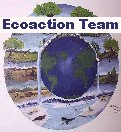





Site Navigation:



   |
The material on the internet is stored on "host" computers that are connected to other computers with sophisticated, expensive, high speed connections. This setup is called a node or domain. When a request for material comes through the interconnected computers that make up the internet, the host computer sends the information back through the connections to the specific computer that requested it.
Although the internet uses a variety of methods to store and transfer information, the method most widely used is The World Wide Web (abbreviated www). WWW documents are primarily text documents that can be created, edited and stored with simple, common software. Embedded in the text are commands inside of brackets that tell the computer that receives the document how to display the document, what graphics to get, how to interact with the user, and commands that tell the user's computer where else it can connect. For example, the commands may instruct the computer that receives the document to get a photo from a different location and display it on the screen in a specific location and size. The commands also may allow you to connect to a new document through text that is highlighted called a hyperlink. This type of coding is known as Hypertext Markup Language, or html.
Writing these html documents is rapidly becoming easier, with every new version of word processors, graphics packages, and presentation software having an option built in to "save as html". More information on html editing is available through the links at the end of this section.
The software running on your local computer is called a browser. This browser software reads the commands and follows the instructions embedded in the brackets. The two main browser programs are the Netscape Navigator and Microsoft's Internet Explorer.
As www documents and browsers became more sophisticated, the instructions became more complex, to the point that many www documents now seem to be more commands and graphics than text. WWW documents are called web pages, a group of related pages is called a web site, and the first page that you see when you visit a site is called a home page.
The hosting of web sites is provided by computers owned and run by a variety of groups and organizations. Universities typically host web sites for their students and staff and other pages related to their public activities. For example, UCONN hosts a variety of CT information, including information on each town. Large corporations often have their own high speed internet connection with dedicated computers and host their own web site. Many government agencies also do this. These organizations are large enough, and use the internet enough to justify the cost of their own node.
Most individuals and small businesses connect to the internet through a company known as an internet service provider or ISP. This business has the sophisticated connections from its computers to the other computers of the internet, and its customers connect to them through regular phone lines. Examples of these ISPs are AOL American Online (which provides other services in addition to connections to the internet), Netplex, Connix, North American Internet (NAI), SNET Internet.
Less common than phone line connections are companies that connect you to the internet in other ways such as cable tv companies like TCI Cablevision, satellite dish connections, and cellular phone connections.
There are also businesses that only host web sites such as Geocities, Angelfire, Acsys.
A decent, simple editor called DIDA! for PCs is available to download at: http://www.ntplx.net/~lsmtmitc/dida.zip




 This page hosted by
This page hosted by